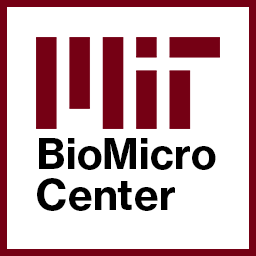BioMicroCenter:News
HOME -- SEQUENCING -- LIBRARY PREP -- HIGH-THROUGHPUT -- COMPUTING -- OTHER TECHNOLOGY
.
Welcome to the MIT BIOMICRO CENTER
BioMicro Center NewsSPRING 2025Spatial Transcriptomics: - The BioMicro Center has recently expanded our spatial 'omics options with the addition of the AVITI24. This upgrade to our existing Element sequencer enables it to do in situ sequencing. For this method, cells are either grown directly onto a flowcell or placed there, fixed and panels of transcripts identified. The system can currently handle up to 350 transcripts and dozens of antibodies with cellular features identified as well (nuclei, cytoskeletin, membrane, etc.). More information is on the Element website. The upgrade was a generous gift from Scott Ritterbush. TO highlight the new capabilities, we have a special seminar upcoming. Molly He, CEO of Element, will be speaking at the KI on May8 (12n). She'll be talking both about the science of the AVITI and the AVITI24, but also about building a company that is competing with the near monopolistic power of Illumina. I hope you can make it to what should be a fantastic seminar. High Output Sequencing: - The BioMicro Center is now supporting sequencing on Illumina's NovaSeqX through collaborations with our sister shared resources in the Boston area. Practically, this will still act like any other sequencing: You will still submit on ilabs and bring the samples to the core. We will preform all the QC and receive the data back, process it, confrim the quality of the data (resolving any technical issues) and place it in your data delivery folders. Since the rates we can share with you are below the published rates, we cannot put these rates on our website, but they are visible in ilabs. Website: - Lastly, the website we have used for well over a decade appears to have failed. Openwetware, a scientific wiki platform, was built at MIT many years ago, starting in Bldg68, and the wiki seemed like a natural fit for the core and worked well for many year. The website failed on us a few weeks ago. We have set up a new page (still reachable at biomicro.mit.edu) but our backup was a few months old. We're working to get it back up to date and apologize for any missing information. If you do have questions or see broken links, please do let us know at biomico@mit.edu |
ABOUT THE BIOMICRO CENTERThe MIT BioMicro Center was founded in 2000 as the core bio-fabrication and microarray processing facility at MIT. The Center is a joint endeavor between the Department of Biology, the Koch Institute for Integrative Cancer Research, the Department of Biological Engineering and the MIT Center for Environmental Health Sciences. The BioMicro Center provides MIT faculty members with integrated facilities for high-throughput data-intensive genomics, bioinformatic analysis, as well as large-scale database storage, management, data mining and data modeling required to fully implement systems approaches to investigate a broad spectrum of biological problems. The BioMicro Center is designed to maximize the likelihood of successfully designing, implementing, and analyzing systems biology data. With an expert staff available for consultation and collaboration, including several full time bioinformatics scientists and experimentalist with significant experience in systems biology, ample resources exist to assist MIT researchers in any aspect of the research project. This unique cross-disciplinary collaboration leverages resources, spreading institutional commitment, and providing an environment that strongly encourages intellectual rapport between scientists that contributes to the success of projects. This collaborative environment creates a unique opportunity for interactions of biologists and biological engineers who study a broad range of problems. Investigators are able to adopt novel techniques to address their topics of interest as well as develop new collaborations throughout the institute. Experimental and analytical work done in the BioMicro Center is funded by the NIH and must be made available through the NIH's open access policy. All Koch Institute and CEHS labs must acknowledge their core grants for work done in the core with the following language.
PUBLICATIONSPublications from Stuart Levine PREVIOUS NEWSLETTERS2017+ RECENT CHANGES TO THE WEBSITE |

